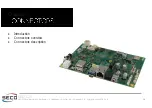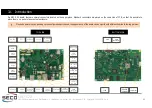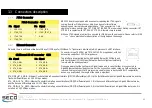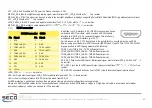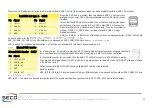
SBC-C20
SBC-C20 User Manual - Rev. First Edition: 1.0 - Last Edition: 1.0 - Author: S.B./ A.R. - Reviewed by C.M. -Copyright © 2020 SECO S.p.A.
15
2.3
Electrical specifications
SBC-C20 needs to be supplied only with an external 12V
DC
± 10% power supply, with a minimal 20W power rating (SBC-C20 power consumption
by itself is around 5W, more power is required for the possible attached devices).
This voltage can be supplied through a Right-angle connector type Molex Mini-Fit Jr, p/n 39-30-0040 or equivalent, with the pinout indicated in the
table below.
RTC Battery
The SBC-C20 board can be equipped with an optional low-power Real Time Clock embedded on the module (which is a NXP PCF2123).
If the board is not equipped with the optional rechargeable battery, then it will be available a soldered horizontal 3V coin cell lithium battery to supply the RTC.
The battery used is a not-rechargeable CR1225 Lithium coin-cell battery, with a nominal capacity of 48mAh.
In case of exhaustion, the battery should only be replaced with devices of the same type. Always check the orientation before inserting and make sure that they are
aligned correctly and are not damaged or leaking.
Never allow the batteries to become short-circuited during handling.
Batteries supplied with SBC-C20 are compliant to requirements of European Directive 2006/66/EC regarding batteries and accumulators. When putting out of order
SBC-C20, remove the batteries from the board in order to collect and dispose them according to the requirement of the same European Directive above mentioned.
Even when replacing the batteries, the disposal has to be made according to these requirements.
Power rails
In all the tables contained in this manual, Power rails are named with the following meaning:
VIN_SYS: +12V
DC
voltage directly coming from the Power Supply connectors CN1
+3P3V_ALW: +3.3V Always voltage, derived from VIN_SYS voltage
Power In Connector CN1
Pin Signal
Pin Signal
1
GND
3
VIN_SYS
2
GND
4
VIN_SYS
CAUTION: handling batteries incorrectly or replacing with not-approved devices may present a risk of fire or explosion.



















